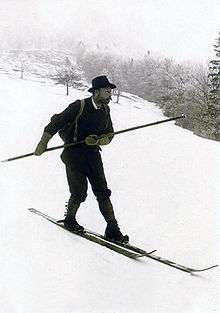Mathias Zdarsky
Mathias Zdarsky (Czech: Matyáš Žďárský; 25 February 1856, in Kožichovice, Třebíč District of Moravia, then Austria-Hungary, present Czech Republic – 20 June 1940, in St. Pölten, Austria) was an early ski pioneer and is considered one of the founders of modern Alpine skiing technique: Arnold Lunn described him as the "father of alpine skiing".[2] He was probably Austria's first ski instructor.[3] He was also a teacher, painter and sculptor.


Inspired by Norway's Fridtjof Nansen's 1888 crossing of Greenland, he adapted skis for use on alpine terrain. In 1890 he developed a steel binding (the "Lilienfelder Stahlsohlenbindung"), which made steep mountain slopes and gate runs possible. Zdarsky felt the earlier bindings did not hold the foot firmly enough, and so he designed binding with a strong, sprung, steel sole, which is the basis of modern ski bindings. As in the earlier Norwegian skiing, he used only one ski pole. Unlike today, the skier steered by using their elbows.
In January 1905, Zdarsky demonstrated a steep downhill descent, and was among the first to publicize this development in Central Europe. To show the superiority of his ski technology, he skied the "Breite Ries" at Schneeberg, Austria. On 19 March 1905 he organized the first alpine ski race (on the Muckenkogel via Lilienfeld, Austria)(though Crans-Montana in Switzerland had already run the first Kandahar descent race, in January, 1901). This had 24 participants. Zdarsky won, making him the first winner of an official ski race. However the event attained little attention beyond ski enthusiasts, so in 1922 the Englishman Arnold Lunn invented the shorter, but more difficult slalom race, which had greater appeal.
During his lifetime nobody suspected Zdarsky had created the basis for a popular sport, and he was considered something of an eccentric inventor. During World War I, he taught mountain troops skiing and advanced avalanche training. He described his skiing techniques in his book Die Lilienfelder Skilauf-Technik (The Lilienfelder Ski Method). First published in 1897, seventeen editions were published up to 1925.
Zdarsky is also thought to be the inventor of the bivouac sack. Mount Zdarsky in Antarctica is named for him.
References
- Zdarsky, Mathias (1897) Lilienfelder Skilauf-Technik Hamburg: Verlagsanst OCLC 601422411
- Schlesinger, Paul (1942) "Mathias Zdarsky, the Pioneer of Alpine Skiing" American Alpine Journal pg 403-405
- Michael Ponstingl, Mathias Zdarskys "Posen des Wissens". Zu einer fotografischen Kodierung des Skifahrens (Mathias Zdarskys "Bits of Wisdom". A photographic manual of ski turns), in: Markwart Herzog (ed.), Skilauf – Volkssport – Medienzirkus. Skisport als Kulturphänomen (Ski Racing - Popular Sport - Media Circus: Sport Skiing as Cultural Phenomenon), Stuttgart: Kohlhammer Verlag, 2005 (Irseer Dialogue [Dialogues of Irsee], Bd./vol. 11), pp. 123–149.
- Allen, John (2008) "Mathias Zdarsky: The Father of Alpine Skiing" Skiing Heritage Journal Vol. 20, No. 1 pp 8–14
- Mathias Zdarsky - 1856-1940 from Lilienfeld museum
- 50. Todestag von Mathias Zdarsky at aeiou.iicm.tugraz.at
- Norden, Gilbert (Spring 2001). "Austrian Sport Museums" (PDF). Journal of Sport History. 28 (1): 87–107. Retrieved 3 January 2017.
- "Britannica.com article on Matthias Zdarsky". Retrieved 2006-10-09.
External links
- Mathias Zdarsky in Austria-Forum (in German) (at AEIOU)
- Zdarsky ski museum in Lilienfeld, Austria (in German)
- Zdarsky archives (in German)